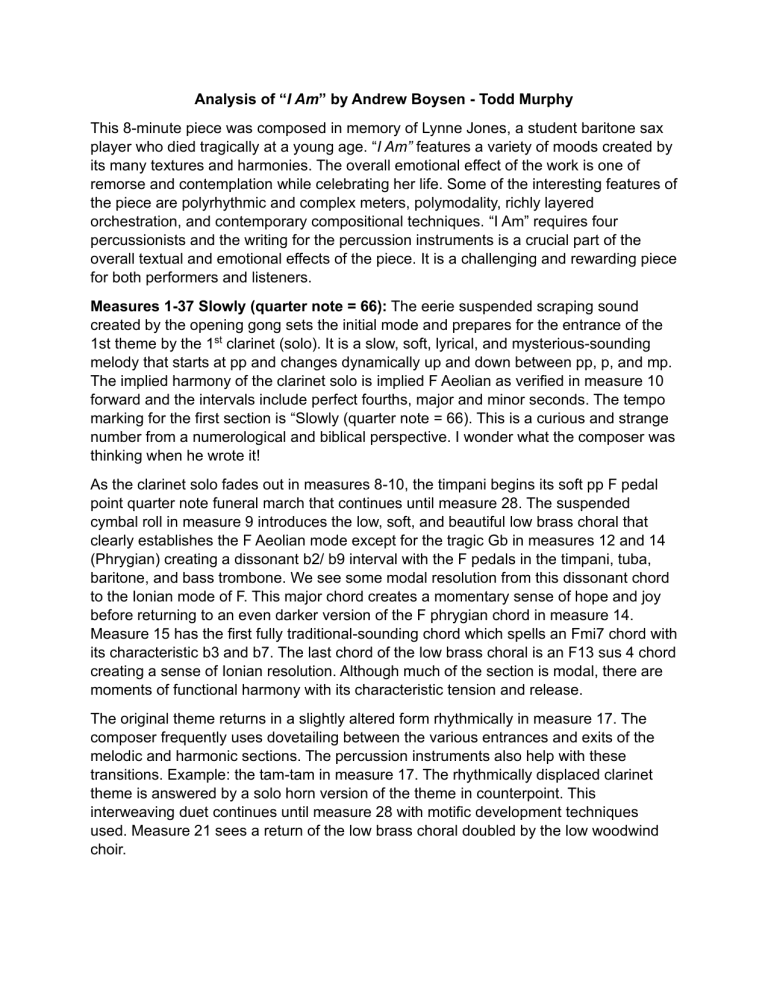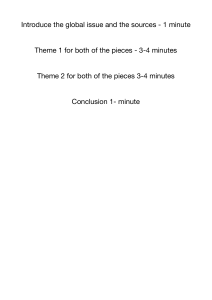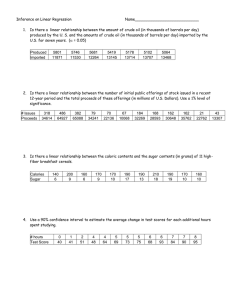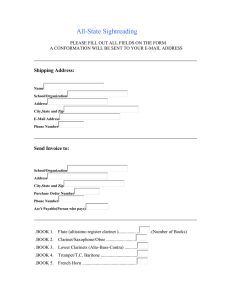
Analysis of “I Am” by Andrew Boysen - Todd Murphy This 8-minute piece was composed in memory of Lynne Jones, a student baritone sax player who died tragically at a young age. “I Am” features a variety of moods created by its many textures and harmonies. The overall emotional effect of the work is one of remorse and contemplation while celebrating her life. Some of the interesting features of the piece are polyrhythmic and complex meters, polymodality, richly layered orchestration, and contemporary compositional techniques. “I Am” requires four percussionists and the writing for the percussion instruments is a crucial part of the overall textual and emotional effects of the piece. It is a challenging and rewarding piece for both performers and listeners. Measures 1-37 Slowly (quarter note = 66): The eerie suspended scraping sound created by the opening gong sets the initial mode and prepares for the entrance of the 1st theme by the 1st clarinet (solo). It is a slow, soft, lyrical, and mysterious-sounding melody that starts at pp and changes dynamically up and down between pp, p, and mp. The implied harmony of the clarinet solo is implied F Aeolian as verified in measure 10 forward and the intervals include perfect fourths, major and minor seconds. The tempo marking for the first section is “Slowly (quarter note = 66). This is a curious and strange number from a numerological and biblical perspective. I wonder what the composer was thinking when he wrote it! As the clarinet solo fades out in measures 8-10, the timpani begins its soft pp F pedal point quarter note funeral march that continues until measure 28. The suspended cymbal roll in measure 9 introduces the low, soft, and beautiful low brass choral that clearly establishes the F Aeolian mode except for the tragic Gb in measures 12 and 14 (Phrygian) creating a dissonant b2/ b9 interval with the F pedals in the timpani, tuba, baritone, and bass trombone. We see some modal resolution from this dissonant chord to the Ionian mode of F. This major chord creates a momentary sense of hope and joy before returning to an even darker version of the F phrygian chord in measure 14. Measure 15 has the first fully traditional-sounding chord which spells an Fmi7 chord with its characteristic b3 and b7. The last chord of the low brass choral is an F13 sus 4 chord creating a sense of Ionian resolution. Although much of the section is modal, there are moments of functional harmony with its characteristic tension and release. The original theme returns in a slightly altered form rhythmically in measure 17. The composer frequently uses dovetailing between the various entrances and exits of the melodic and harmonic sections. The percussion instruments also help with these transitions. Example: the tam-tam in measure 17. The rhythmically displaced clarinet theme is answered by a solo horn version of the theme in counterpoint. This interweaving duet continues until measure 28 with motific development techniques used. Measure 21 sees a return of the low brass choral doubled by the low woodwind choir. Boyson’s clever use of dovetailing can be seen again in measures 27-28 as the funeral march comes to an energetic close. Measures 27-33 feature a polyrhythmic ostinato pattern duet between the marimba and bells on alternating Db octaves. This brings in the first entrance of the flutes in the pickup to measure 29 with a triadic choral based on fragments of the main theme. The harmony is implied F Phrygian although the root has subsided. You could also look at it as major triads in inversion against the Db ostinato. The saxes make their first entrance in measure 33 with more fragments of the theme coupled with the flute choral. This abruptly ends in measure 34 except for the short thematic baritone sax solo preparing the transition to the next section. Measures 37-80 Fast (quarter note = 144): This section is quite contrasting to the first section in tempo and character. It features fast rhythm, complex harmonies, and a highly energetic and dynamic nature. There is a sense of forward motion in this section, which is driven by the rhythmic intensity and constant energy of the section. There are several conversations between the different sections. For example, the low brass (minus tuba) and the horns enter with alternating staggered harmonic pads that outline the same tonalities as seen earlier. Note the use of more dovetailing creating a sense of continuity where no breathing is required. The alto saxes also join in with the horns which is a nice orchestrational touch. Once again, the clarinet section supplies the new theme although this time it is a Tutti statement presented by the 1st clarinets. In the pickup to measure 45, the theme is passed to the flutes for a restatement. Measure 45 sees the first entrance to the cornets and trumpets with a more rhythmic accompaniment. The wood blocks are doubling these figures until measure 52. There is a gradual building as more percussion and wind instruments enter leading up to the first climatic point at measure 55 which is quasi tutti and fortissimo. Measure 55 is the start of a long fortissimo duet between the unison flutes and unison clarinet sections which continues to measure 69 as the tapering off of instruments and lowering dynamics begins to lower the energy for the upcoming transitional and developmental section at measure 81. In measure 59, the horns enter along with the baritone horn with an augmented statement of the original theme. Measures 62-70 bring the tutti orchestration back and we see the first use of complex meters in alternating measures creating polyrhythmic energy. There is some poly modality in this section, but in general, the same notes from the previous section are employed. Measures 67-80 see a long diminuendo as the intensity drops by reducing instrumentation and dynamic level. Stylistically, these first 2 sections show a number of different influences, including classical, jazz, and rock. The use of extended tertian harmonies, complex rhythms, and angular melodies is reminiscent of the modern classical style, while the driving rhythm and energy of the music have echoes of rock and jazz. It is my guess that Lynne Jones enjoyed these three distinctively different styles. Measures 81-94 Much Slower (quarter note = 72): This slow transitional and contrasting section is highly developmental with repeated material from the first two sections in whole and fragmented forms. It has a completely different character than the first sections with much dissonance and scary music—perhaps to signify death or tragedy. The mallets return with the Db ostinato while a developed version of this appears in measures 86-94. Measures 93 and 94 feature some more dissonantsounding clusters in the low brass section along with the low wws joining in. These two bars also sport a long ritardando becoming slower and slower up to the Senza Misura in measure 95. The emotional effect of this section is highly expressive and emotional, with a sense of yearning and introspection coupled with a sense of calm and stillness. Stylistically, this section draws on a variety of influences, including contemporary classical music, film music, and popular music. The use of simple, expressive melodies and stable harmonies is reminiscent of film music and other popular styles, while the introspective mood and emotional depth of the music are characteristic of contemporary classical music. Measure 95 - Senza Misura Section (without measure): Senza Misura is used to indicate that a section of music should be played without a strict or specific sense of meter or time signature. Instead, the music should be played in a more free-flowing and expressive manner, with a greater focus on the overall feeling and emotion of the music rather than adhering to a strict beat. The transition from the last section to the Senza Mistura is amazing and one hardly notices the radical change in scoring and the lack of meter. Upon first listening, one gets the impression of a totally free-form improvisation which is often a characteristic of such meterless compositions. The effect is that of an eerie place where time and reason end and nothing is certain. The individual voices within the ensemble are able to move and flow around each other, creating a sense of interplay and conversation that adds to the emotional depth and power of the music. This is probably the most difficult section to perform namely because the different freeform lines are in unison with many instruments participating which could be hard to hold together with so much going on. When I first got to Brazil many years ago, I was fortunate enough to participate in a cool group that did this type of contemporary music. It was demanding and fun to play, but difficult! Measures 95-100 Fast (quarter note = 144): This short section is another transition from the abstract Senza Misura section to the upcoming slow section at measure 101. The way the section builds up from the last section to the 3-fff climax is impressive and the focal chord is stacked with all the fixin’s. Again, the masterful orchestration leading up to the Senza Misura and the orchestration leaving the meterless section is masterfully done and hardly noticeable. The chord at 100 is the first real tutti with all 4 percussionists playing. The only notes I could not find in this chord were d and d flat, but they are probably there somewhere if I looked more closely. That is the famous everything but the kitchen sink chord complete with clusters and dissonant rubs from top to bottom. Cool Chord!! Measures 101-124 Slowly (quarter note = 60): Much of the remaining measures of the composition are based on the Ab Ionian mode with a pedal Ab. This is especially true for the recurring angel voices singing “I Am”. The harmony is more functional up toward the ending and it reminds me of the film scoring at the end of a happy movie where the hero finds his way to heaven escorted by angels. The clarinet is once again the featured soloist with a melody reminiscing of the original melody. We also find the mallets returning to the pointillistic octave patterns in a polyrhythmic but minimalistic fashion. The reuse of material brings the piece together. Measure 177 starts a build-up to the triumphant brass choir with the whole woodwind section plus the alto sax performing a happy and playful melody up to the wonderful brass choir choral at 125. Measures 125-145 Much Fast (quarter note = 120): Boysen shows off the power of a full brass section in a legato fashion which would make any other section envious! The style of the choral is that of a great procession as our hero graduates to heaven’s doors and makes a grand entrance. The harmony is quite functional and sets up a wonderful Hollywood-style climax at measure 135! Trills in the woodwinds and bells as the brass choral becomes a triumphant battle cry with 3-fff accented chords full of 3rds and 3rd relation progressions. There is a great example of contrary motion as the basses rise and the trumpets fall to another decay to the final slow section. I didn’t analyze the harmony but I can sort of tell what they are and which devices the composer used to compose the passage. It is very John Williams mixed with Wagner that you would expect at a great royal procession. Final: The piece ends softly and slowly with material from before accompanying the return of the angel voices over the Ab pedal. The melody steps from the 9th to the major third as it repeats “I Am” several times. Very Hollywoodish! As the hero fades off into oblivion, you can hear her finish the phrase “I AM……… Home”. Not really! I just made that part up.



